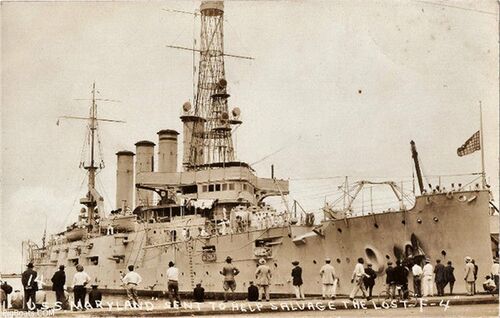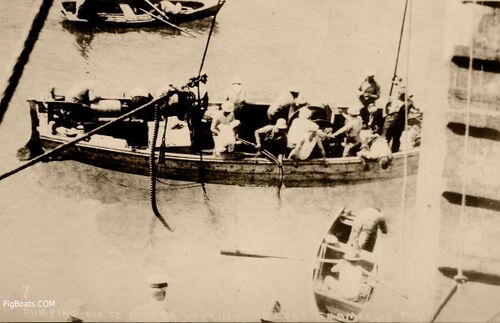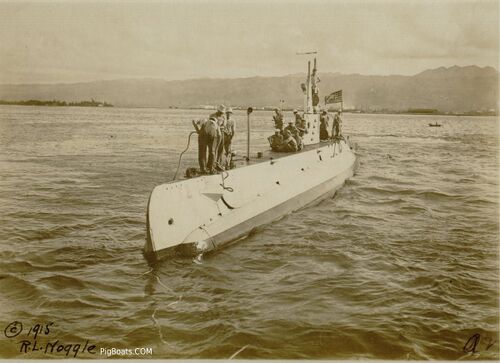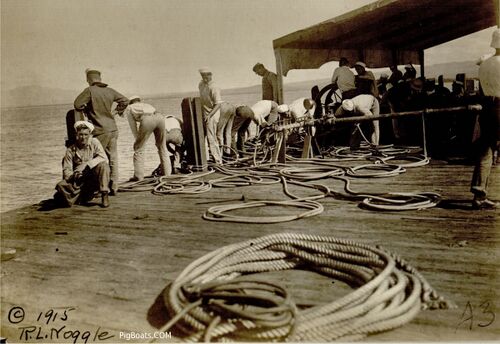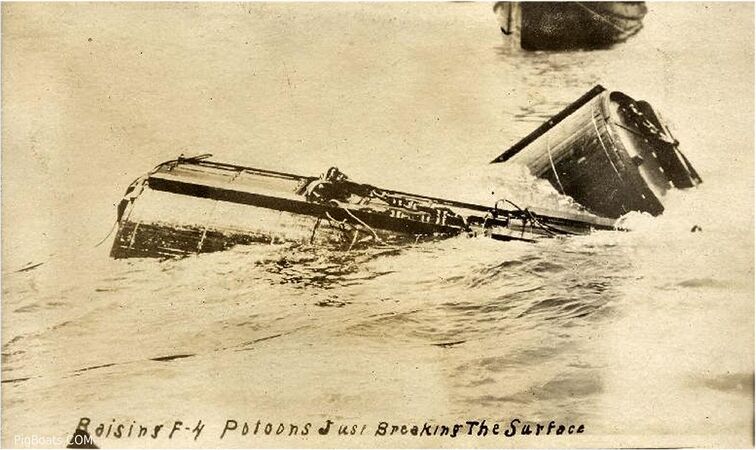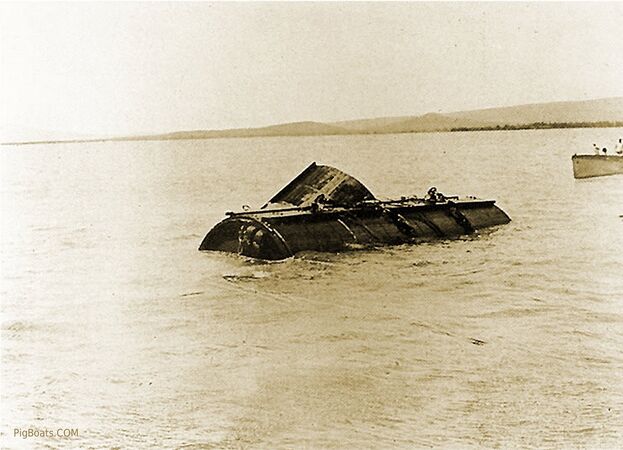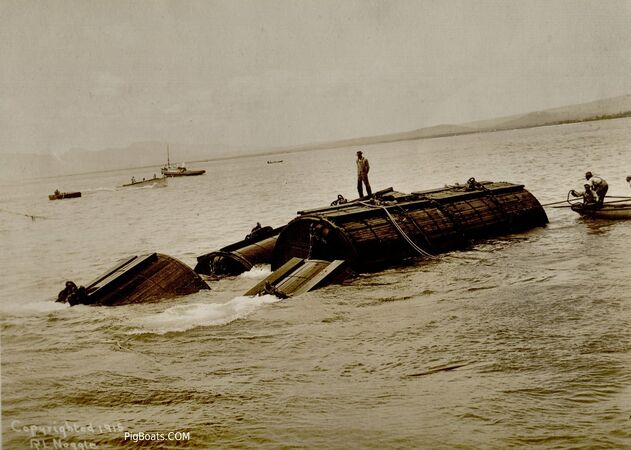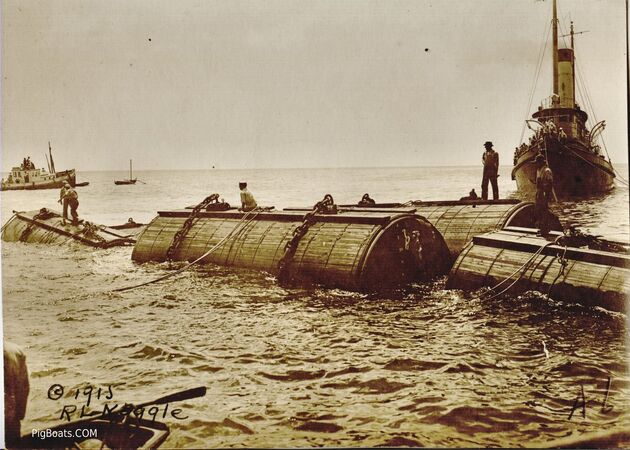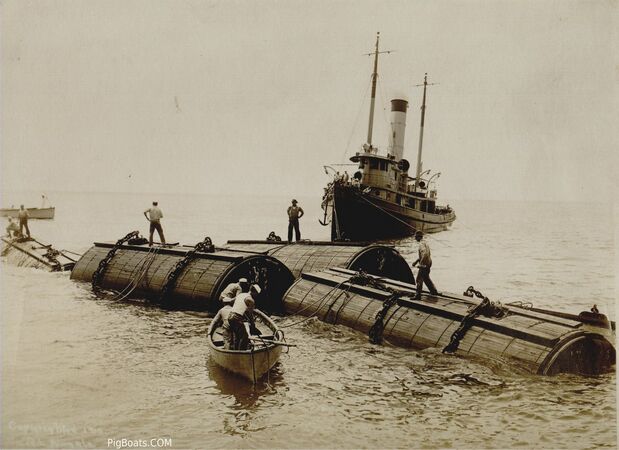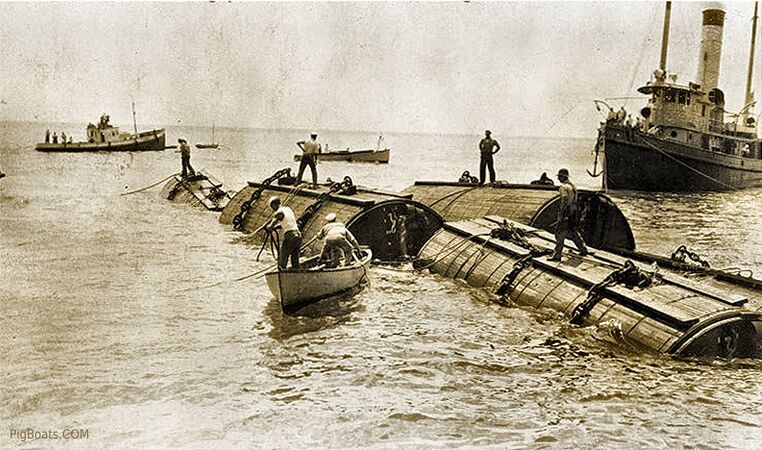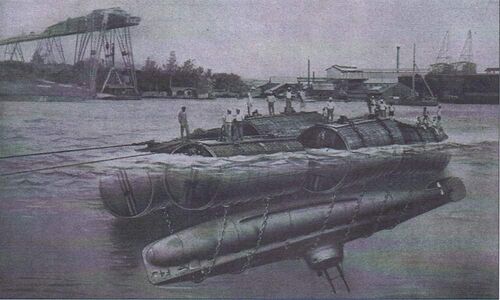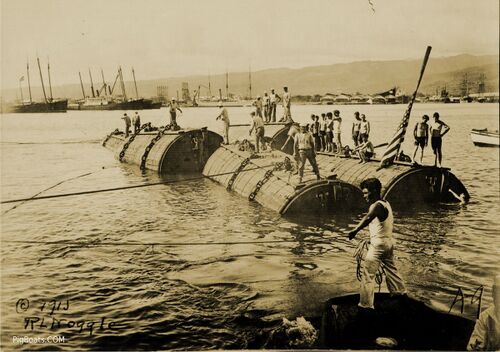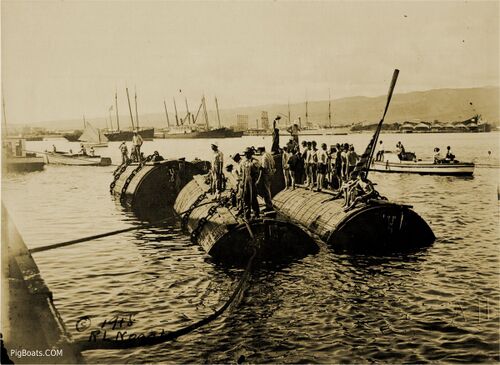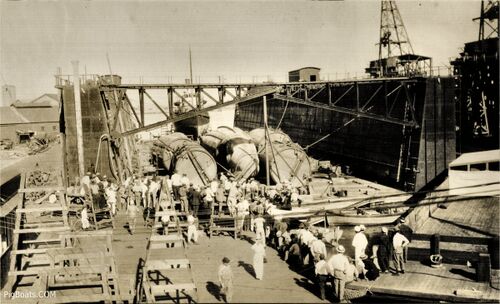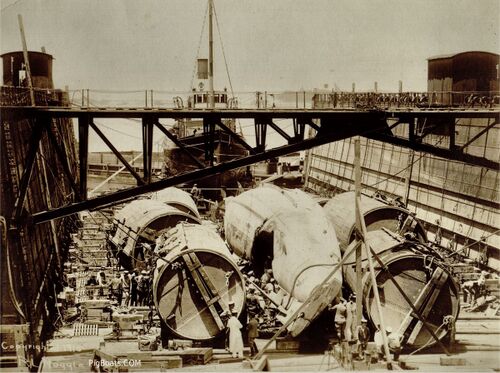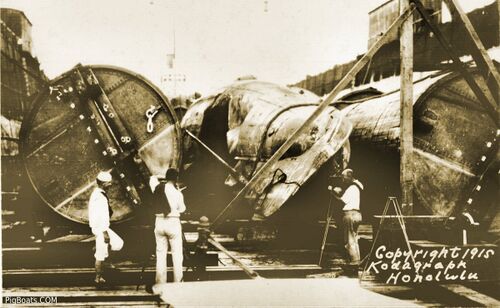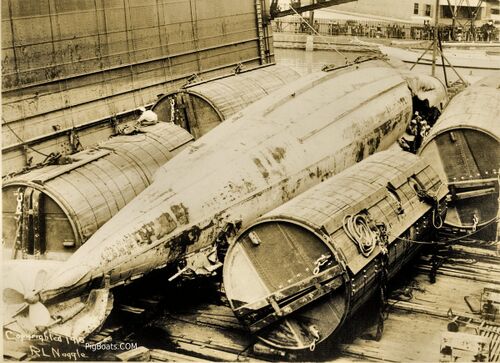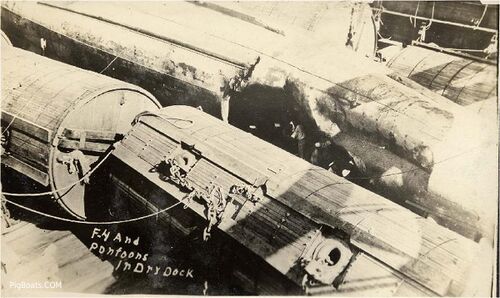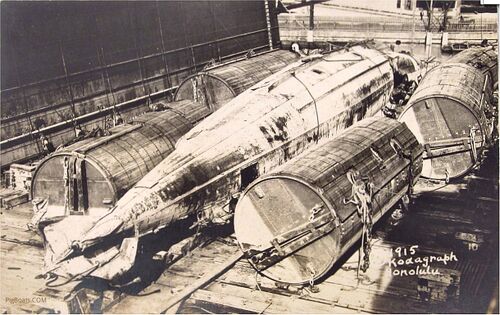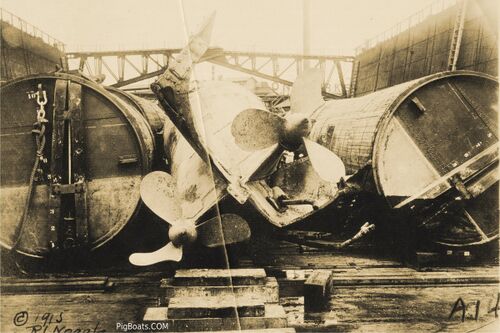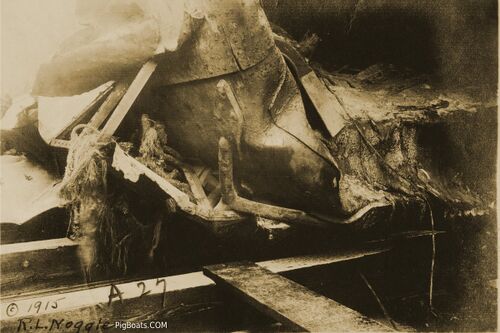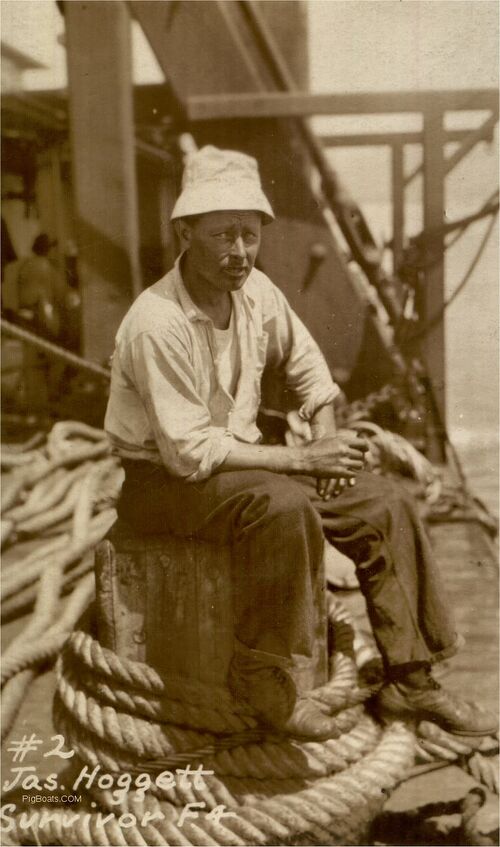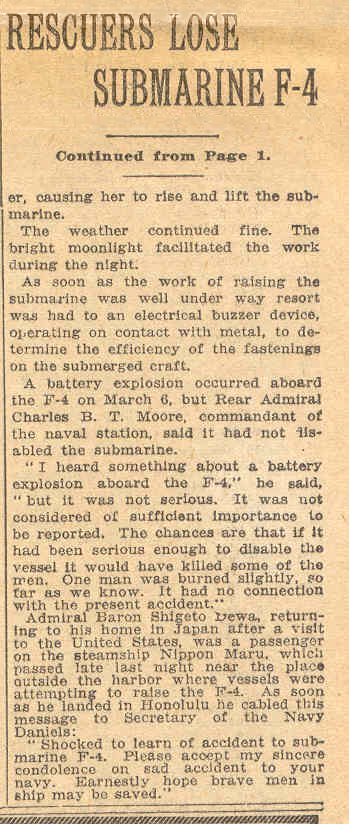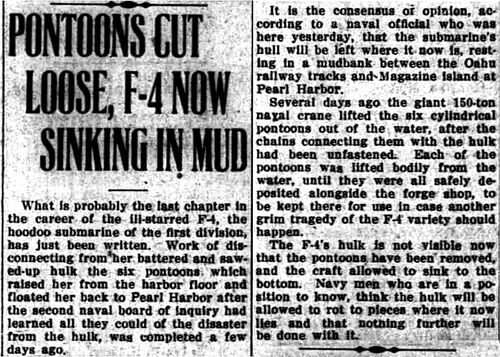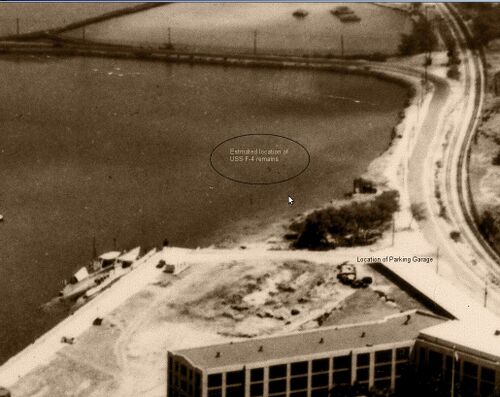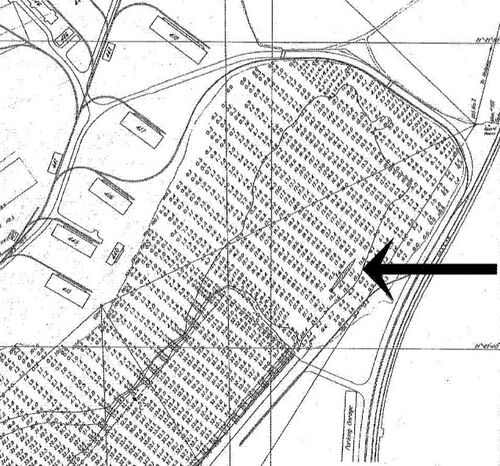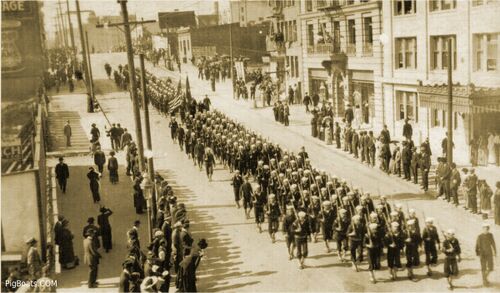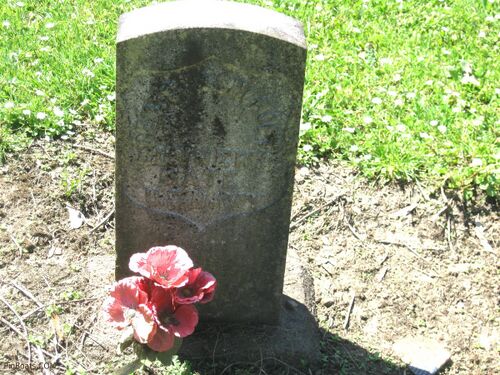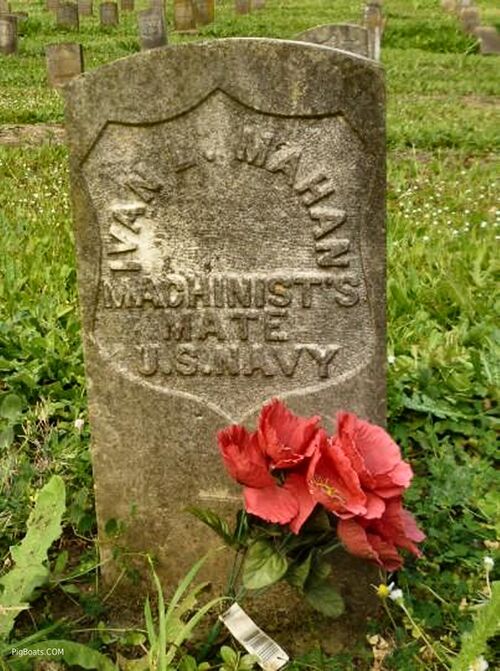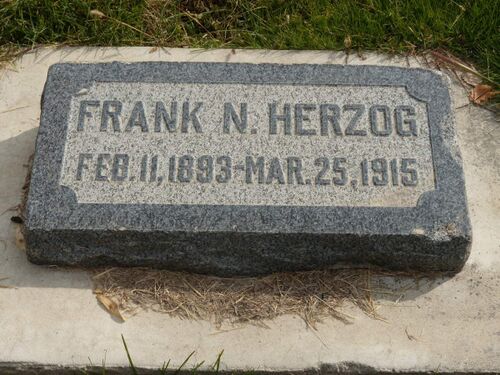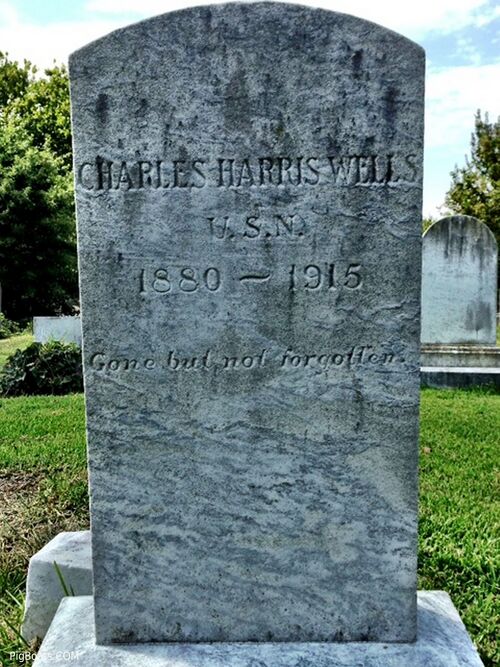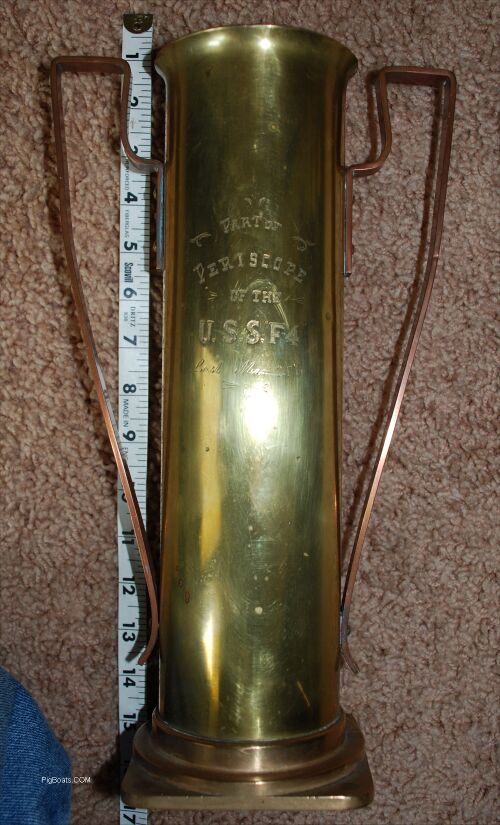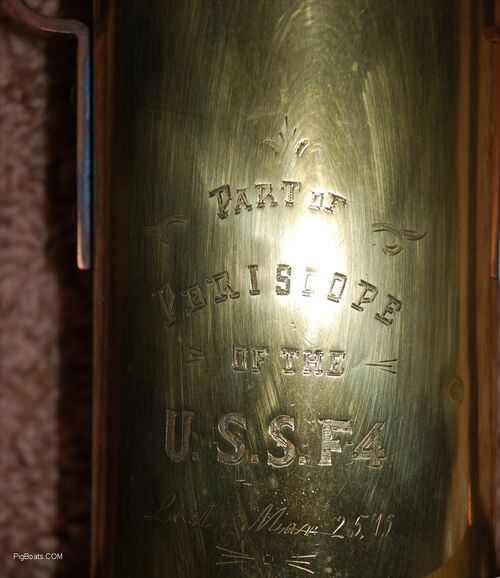F-4 salvage: Difference between revisions
Pbcjohnston (talk | contribs) Added photos and formatted |
Pbcjohnston (talk | contribs) Added captions and formatted |
||
| Line 3: | Line 3: | ||
=== <big>Search for the Lost Boat</big> === | === <big>Search for the Lost Boat</big> === | ||
[[File:F-4 salvage 1.jpg|left|500px]] | [[File:F-4 salvage 1.jpg|left|500px]] | ||
<div style="text-align: justify;"><span style="color:#00008B"> | <div style="text-align: justify;"><span style="color:#00008B">Once it was realized that F-4 had not returned when it should, all manner of craft went out from Honolulu to search for the boat. It must be remembered that in 1915 Hawaii was an undeveloped paradise with little modern infrastructure. The F-boats were based in Honolulu because the base at Pearl Harbor was in its infancy and was not yet capable of supporting warships. In 1915 Hawaii was still a remote outpost. | ||
Here two men are using a box with a glass plate in the bottom that allowed a clearer view of things underwater. | |||
<small>Photo in the private collection of Ric Hedman.</small> | <small>Photo in the private collection of Ric Hedman.</small> | ||
| Line 10: | Line 12: | ||
[[File:F-4 salvage 2.jpg|left|500px]] | [[File:F-4 salvage 2.jpg|left|500px]] | ||
<div style="text-align: justify;"><span style="color:#00008B">Early in the search the Navy was using every means to locate the lost submarine. All they had to go on was some air bubbles and oil. They began dragging grapples in hopes of snagging the lost vessel. These hopes were soared when a heavy object was hooked. It turned out to be the lost three and a half ton anchor from the battleship USS Oregon (BB-03). The Oregon lost her port anchor on May 30, 1901 due to a defective link that nearly killed Chief Bosun J.E. Murphy when the link parted. Murphy was a hero in the Battle of Santiago during the Spanish-American War. | |||
According to the Board of Investigation Report, when the weight of the anchor was discovered Jack Agraz, Chief Gunners Mate, a Navy diver from the USS F-1, donned his gear and followed the line to the target. Three crews of four men each manned the hand turned air pump suppling air to him. He discovered the grapple chain was wrapped around "an old anchor" at 215 feet. The F-4 had not been found. | |||
<small>Photo in the private collection of Ric Hedman.</small> | |||
[[File:Red bar sub new.jpg]] | |||
[[File:F-4 salvage 3.jpg|left|500px]] | [[File:F-4 salvage 3.jpg|left|500px]] | ||
<div style="text-align: justify;"><span style="color:#00008B">Another false alarm when part of the periscope was discovered. Newspaper article describing the early search that went on for the F-4 and the recovery of a portion of one of her periscopes. | |||
<small>Photo in the private collection of Ric Hedman.</small> | |||
[[File:Red bar sub new.jpg]] | |||
[[File:F-4 salvage 7 agraz.jpg|left|500px]] | |||
<div style="text-align: justify;"><span style="color:#00008B">Chief Gunners Mate (Torpedo) John "Jack" Agraz, USN was a diver and a crewmember on the F-4's sister boat F-1. Agraz would make dozens of dives during the search for F-4. He was a large and powerful man, with the constitution of an ox. His friends described him as fearless and determined, full of guts and stubbornness. He had been born in Guadalajara, Mexico in 1879 and had come to the United States in 1904 seeking adventure, which he found in the U.S. Navy. He made dives to over 200 feet with a Schrader Mk IV diving helmet and breastplate resting on his shoulders, ''without wearing a watertight diving suit or weights!'' He wore only long john underwear and a pair of deck shoes. He did not decompress on the way up (that was still a developing science) and never suffered from the bends. He was performing physical feats that astounded the men he worked with. His bravery was unquestioned. | |||
<small>Photo in the private collection of Ric Hedman.</small> | |||
[[File:Red bar sub new.jpg]] | |||
[[File:F-4 salvage 4.jpg|left|500px]] | [[File:F-4 salvage 4.jpg|left|500px]] | ||
<div style="text-align: justify;"><span style="color:#00008B">As stated above, in March 1915 the U.S. Navy presence in Hawaii was still in a very early stage. Most of the routine diving tasks involved shallow water dives (less than 50 feet) in warm tropical waters. Because of this, most divers (including Jack Agraz) simply perched the diving helmet and breastplate on their shoulders and did not use a waterproof suit or weights. This is a Schrader Mk IV helmet and breastplate sitting on a diving launch during the F-4 operation. It may have been used by Agraz on one of his incredible deep dives. It is sitting on a hand-cranked air pump and facing to the left. The air pump was hand-cranked by two burly men and was used to send air down to the diver. The helmet and breastplate are rigged up with a heavy line that will allow the diving tenders to lower the helmet into the water so that the diver can rest it on his shoulders. With the air being sent down by the men operating the pump, the water level was usually just below the diver's chin when he was submerged. The diver could easily duck out from the helmet and swim to the surface if he ran into trouble. In this mode the helmet was being used like a shallow water helmet, fine for shallow dives but exceedingly dangerous for deep water dives like what was needed to reach the F-4. Agraz made a dive to 215 feet with one of these rigs perched on his shoulders. Author Jon Gates has stated that Agraz preferred to dive this way, as it gave him a degree of freedom that he wouldn't have had it he was wearing a suit. However, it is actually likely that there were no diving suits available in Hawaii at the time, thus giving him no choice. | |||
<small>Photo in the private collection of Ric Hedman.</small> | |||
[[File:Red bar sub new.jpg]] | |||
[[File:F-4 salvage 5.jpg|left|500px]] | [[File:F-4 salvage 5.jpg|left|500px]] | ||
<div style="text-align: justify;"><span style="color:#00008B">A rather crowded diving launch hovering over the scene of F-4's sinking. Given the fact that none of the men appear to be operating the pump, it is likely that there is not a diver in the water from this launch. The men are intently trying to peer though the water, with one man using a glass bottomed bucket to try to see better. Most of the diving on the F-4 was conducted from these launches, as there were no specialized salvage ships in Hawaii at that time. | |||
<small>Photo in the private collection of Ric Hedman.</small> | |||
[[File:Red bar sub new.jpg]] | |||
[[File:F-4 salvage 6.jpg|left|500px]] | [[File:F-4 salvage 6.jpg|left|500px]] | ||
<div style="text-align: justify;"><span style="color:#00008B">Here is an interesting action photo. It appears that a diver has come to the surface (possibly Agraz) and had his helmet and breast plate removed and then he has slid back into the water. You can see his form under water. One man has his arm into the water and looks to have a hold of him. A second man is reaching for him and everyone else is looking on in concern. Someone may have pulled the helmet off too early. | |||
<small>Photo in the private collection of Ric Hedman.</small> | |||
[[File:Red bar sub new.jpg]] | [[File:Red bar sub new.jpg]] | ||
<div style="text-align: justify;"><span style="color:#000000"> | |||
=== <big>Salvage Work</big> === | === <big>Salvage Work</big> === | ||
</div> | |||
[[File:F-4 salvage 8.jpg|left|500px]] | [[File:F-4 salvage 8.jpg|left|500px]] | ||
Revision as of 15:16, 8 September 2023
Search for the Lost Boat
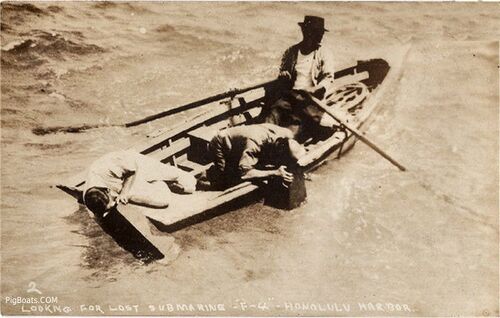
Here two men are using a box with a glass plate in the bottom that allowed a clearer view of things underwater.
Photo in the private collection of Ric Hedman.
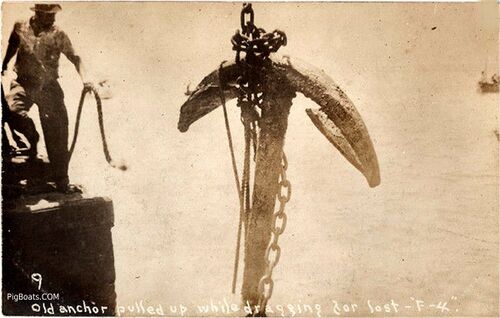
According to the Board of Investigation Report, when the weight of the anchor was discovered Jack Agraz, Chief Gunners Mate, a Navy diver from the USS F-1, donned his gear and followed the line to the target. Three crews of four men each manned the hand turned air pump suppling air to him. He discovered the grapple chain was wrapped around "an old anchor" at 215 feet. The F-4 had not been found.
Photo in the private collection of Ric Hedman.

Photo in the private collection of Ric Hedman.

Photo in the private collection of Ric Hedman.
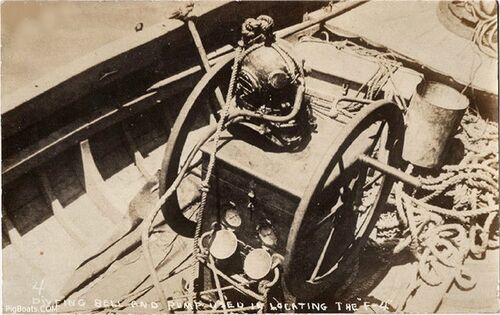
Photo in the private collection of Ric Hedman.
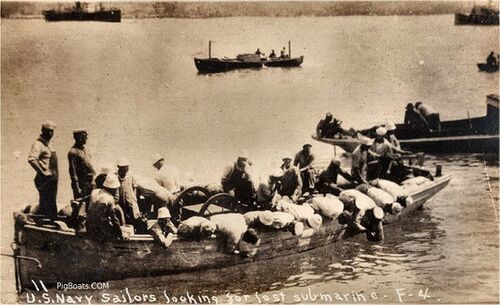
Photo in the private collection of Ric Hedman.

Photo in the private collection of Ric Hedman.
Salvage Work


